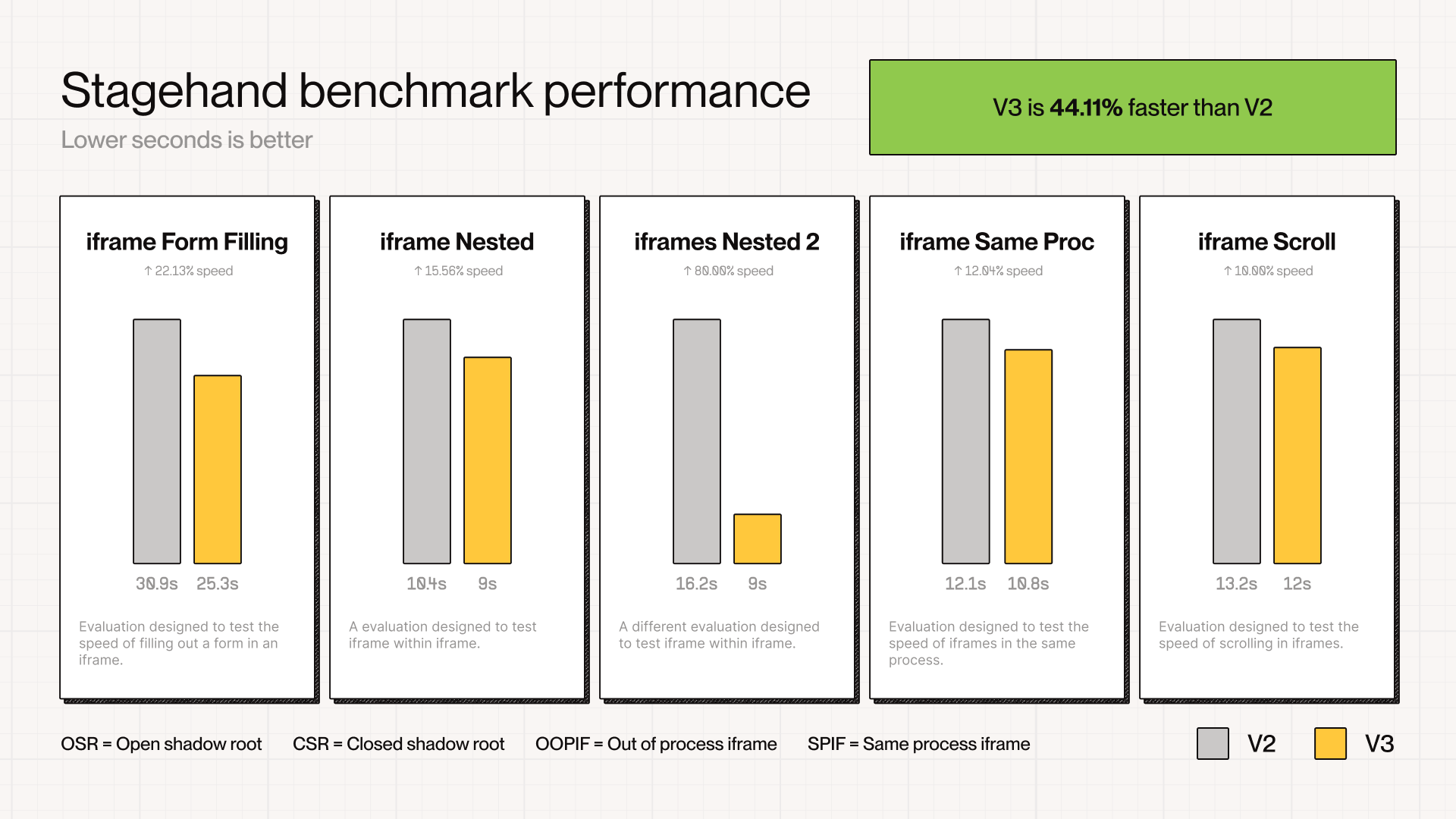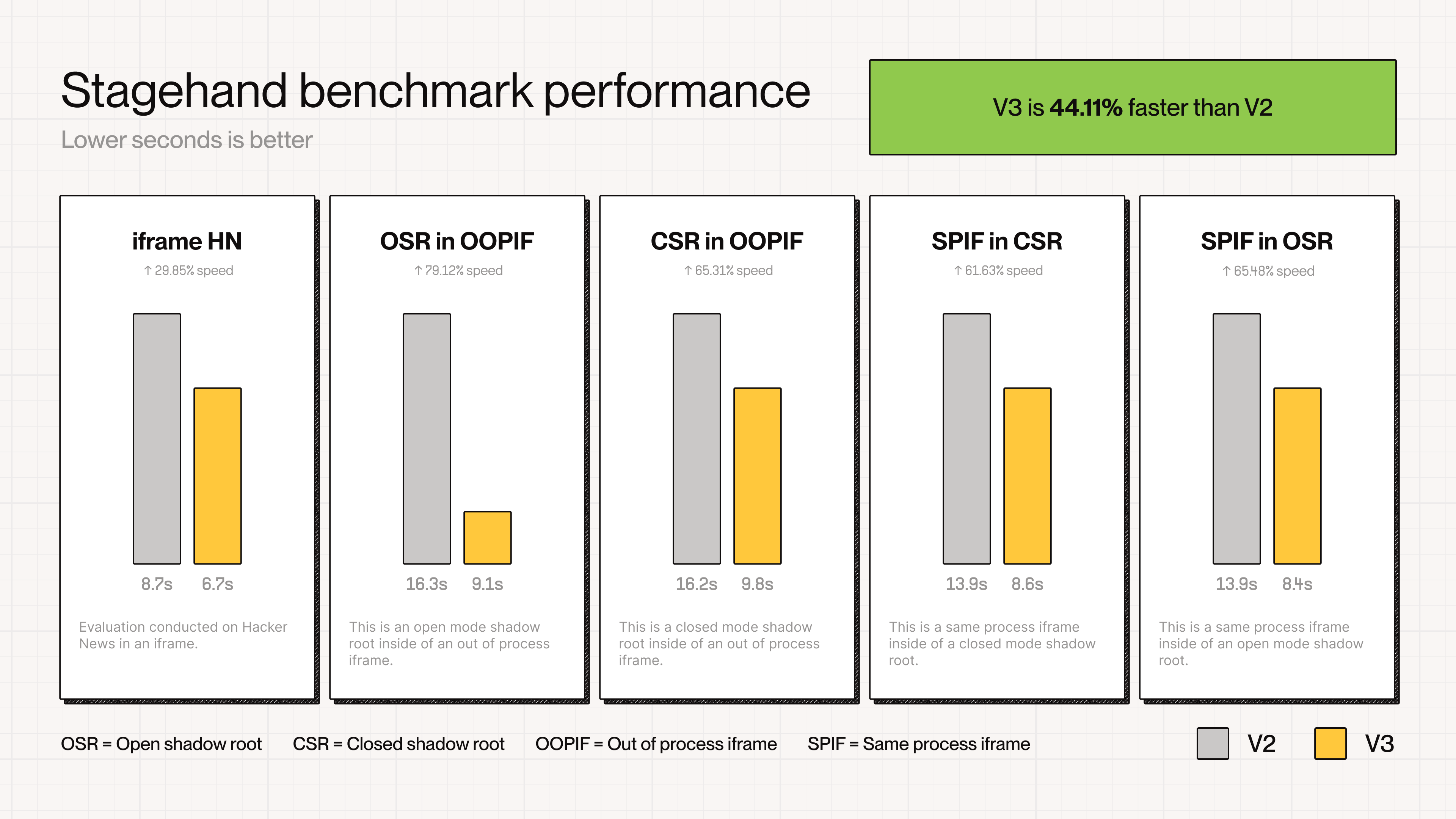
Launching Stagehand v3, the best automation framework
TL;DR: We’re launching the best automation framework.
So, you probably should read all the details. ;)
Stagehand v2 took off, with half a million weekly downloads, hundreds of production automations, and a growing ecosystem of Browserbase users. But the more people built with it, the clearer the limits became: it was fast, but not fast enough, and ergonomic, but not open enough.
Today we’re launching the fix for that: Stagehand v3. It’s the best automation framework, and we mean it when we actually call it the best this time. It’s the most extensible, reliable, and AI-ready version we’ve ever built, and it’s 44.11% faster on average across iframes and shadow-root interactions.
Copy linkWhat’s new?
- Extensible (You can use Stagehand with Puppeteer, Playwright, Bun, and more).
- Reliable (Stagehand can talk to any website, including iframes/shadow DOMs).
- Fast (We re-wrote it from scratch and v3 talks directly to the browser using Chrome Dev Tools Protocol (CDP), minimizing round trip time (RTT)).
- Built for Automation (We’ve optimized Stagehand for automation, not for testing).
- Optimized for AI (Our new context builder reduces token waste).
Copy linkWhy we’re graduating from playwright
Playwright got us here. It gave Stagehand a strong foundation and a fast on-ramp, since developers could drop Stagehand into existing Playwright scripts and start shipping AI-driven automations in minutes. That compatibility was key to early trust and adoption.
As usage scaled, though, we began to see the seams between a testing-first framework and an automation-first runtime. Playwright’s actionability checks and auto-waiting are ideal for tests, but they add overhead in automation scenarios where throughput and control take priority.
We also needed deeper CDP-level control, particularly for iframes and multi-tab workflows. Building rich context for models means streaming accessibility trees, DOM snapshots, and network events directly from Chrome DevTools Protocol. Playwright’s abstractions made that harder than it needed to be.
Finally, long-lived automation sessions demanded a different operational profile: lighter memory use, faster frame-scoped routing, and fewer websocket round-trips.
Stagehand v3 builds on those lessons. We’ve moved beneath the test layer to operate natively at the protocol level and set a new foundation for automation tasks, while still keeping the ergonomics we all love.
Copy linkFrom framework to platform
At the architectural core, v3 removes the Playwright dependency and introduces a modular driver system. Stagehand now works seamlessly with Puppeteer or any driver built on the Chrome DevTools Protocol.
This shift unlocks faster iteration, full portability across environments (including Bun), and smoother CI/CD integration. More than a framework, Stagehand is now an automation platform built for hosted browsers, agents, and AI.
Copy linkSpeed you can feel
Stagehand v3 is built for real, measurable speed across the kinds of environments where automation usually slows down. Our benchmarks highlight performance across deeply nested iframes and shadow DOMs, some of the hardest surfaces in modern web automation.
Across this suite, v3 completes actions 44%+ faster overall, consistently outperforming v2 across every scenario.

The result is clear: faster execution across every benchmark, tighter control loops, and automation that simply feels more responsive, especially on Browserbase, where network-layer optimizations amplify the difference.

Copy linkBuilt for automation
Stagehand v3 keeps its focus on real automation, where it belongs. We promise ease to control browsers, after all. v3 is built for agents, scrapers, copilots, and browser-native workflows that are primed for execution, not just testing.
Copy linkOptimized for AI
Instead of treating AI as an add-on, we re-architected Stagehand to be AI-native from the ground up. v3 now automatically caches discovered elements and actions that you can reuse without any additional LLM inference cost or time, and intelligently involves AI when workflows break.
Common user actions are repeatable and predictable, ensuring agents can operate reliably across changing page states. Its new context builder reduces token waste by feeding models only what’s essential, while a self-healing execution layer adapts in real time when a DOM or layout shifts. And with a new, model-agnostic Agent Mode, Stagehand lets you pair these capabilities with any LLM or CUA (computer use agent) without changing your workflow.
The result is automation that feels purpose-built for AI: efficient, resilient, and ready for whatever model you plug in next.
Copy linkWhy this matters
The browser has become the universal interface for automation and the front end of the modern agent stack.
Stagehand v3 makes that interface programmable, stable, and fast.
“Our Stagehand v3 workflows are noticeably snappier when run side-by-side with v2. We now get detailed observability and token-level reporting per action, which speeds up debugging and helps us optimize caching to save on model costs.”
— Steve Austin, Co-Founder & CTO @ Benny
Copy linkWhat’s next 🤟
By moving closer to the browser, shedding unnecessary dependencies, and optimizing for AI from the ground up, we’ve made Stagehand faster, more flexible, and ready for whatever you’re building next.
If you’re an existing Stagehand user, upgrading from v2 is simple. Check out the migration guide to get started. If you’re new here, the docs walk through everything you need to install, connect, and run your first automation in minutes.
v2 made browser automation accessible, and now v3 makes it unstoppable. Try it today and see what your browser can really do. :)
Get started: npx create-browser-app
 Try Stagehand v3Start automating
Try Stagehand v3Start automating


